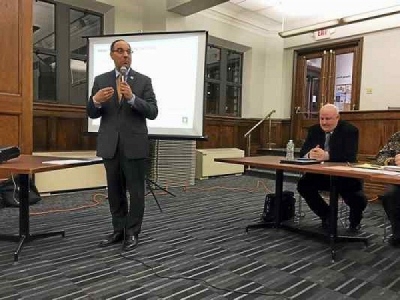
Posted on January 26, 2017
By Mary O?Leary, New Haven Register
Three years from now, the city hopes a harbor dredging project that will allow the port to increase business and compete with other major shipping centers along the Northern Atlantic Coast will be approved with federal funding in place to start the work.
The New Haven Port Authority, under its Executive Director Judi Sheiffele, has been preparing for the U.S. Army Corp of Engineers to kick off the project study since 2015.
Corps representatives Tuesday night laid out the $3 million study process in a meeting designed to give the public a chance to comment, although there will be more specifics to discuss at the next corps meeting in September, with a draft by April 2018.
The corps will come up with a cost benefit analysis of increasing the depth of the channel from 35 feet up to 42 feet, as well as proposed alternative uses of the dredged materials.
Advertisement
The final report for the estimated $40 million to $50 million dredging work will be out by November 2019.
New Haven is the busiest of the state’s three ports, with its seven terminals where from 13 to 15 international ships unload monthly. This compares to one or two cargo ships coming to New London, according to Evan Matthews, the state’s director of the Connecticut Port Authority.
“The vast amount of cargo and trading is happening in New Haven,” Matthews said.
If the federal government authorizes a channel depth of 42 feet, “that puts New Haven and the state of Connecticut up with the largest ports,” in the Northern Atlantic, including Boston and New York, he said.
“Thirty-five feet is not deep enough to compete in the 21st century,” Matthews said.
Sheiffele said the terminals continue to upgrade their facilities to maintain their competitiveness and are committed to additional investments to accommodate deeper draft vessels.
Michael Piscitelli, deputy economic development administrator in New Haven, asked that the corps consider several things as it goes about its review.
He asked that it look at using the dredged materials to help make the harbor area, which was hit hard by Superstorm Sandy and Hurricane Irene, more resilient.
Piscitelli also requested that the corps be sensitive to the shellfish industry which has beds in the harbor.
The third area Piscitelli addressed is the Cross Sound Cable, a trans-energy line installed in 2000, which will have to be moved to accommodate the new proposed depth.
He reminded the corps that the community was quite vocal when the cable was put in that it not have an adverse impact on the deepening project.
“I trust that you will keep that front and center in your mind as you go through the cost-benefit analysis,” he said. Piscitelli said he hopes they make it work for “all the parties that use the channel.”
He said the port is also located within a neighborhood and he hopes their voices will also be heard,
The federal permit for the cable says it is responsible for moving it, if needed, but there is still a question of the cost, according to Mark Hable, the moderator of the presentation, and chief of the navigation and environmental studies section of the corps.
He said the city and state could argue that this additional cost not be included in the cost-benefit analysis, but such factors usually are.
Barbara Blumeris, project manager for the New Haven dredging plan, said a benefit of being able to use larger vessels is the reduction in tidal delays and “lightering costs,” when a ship has to unload a cargo piecemeal onto barges.
She said a deeper draft can result in a cost savings and a more efficient process for shippers, thereby increasing users in the harbor.
Charles Jones, a Connecticut harbor pilot, said a one-day delay for a shipper to unload can cost as much as $25,000.
Habel listed the many uses for the projected 4 million cubic yards to 5 million cubic yards of dredged material that will likely be moved.
He said they range from marsh restoration to beach nourishment to creation of islands. It has also been used for coastal resiliency or for upland transport for use in brownfields. Habel said there would be a cost-sharing factor for all of them.
The city’s port moves the highest volume of goods on Long Island Sound with 8.7 million tons of cargo handled in 2014, and is ranked 59 out of 150 ports in the U.S. by the corps.
Source: New Haven Register





